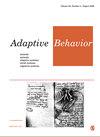Coupling First-Person Cognitive Research With Neurophilosophy and Enactivism: An Outline of Arguments
IF 1.3
4区 计算机科学
Q4 COMPUTER SCIENCE, ARTIFICIAL INTELLIGENCE
引用次数: 0
Abstract
A core issue of embodiment is the question of how phenomenal and agentive consciousness relates to external forms of behavior. Instead of biasing the question in terms of the “hard problem” as to why and how consciousness arises from brain processes (D. Chalmers), it is suggested to ask for psychophysical correlations in a metaphysically neutral way. This, however, demands (1) to explore both sides of the problem with equivalent precision and depth—not only the physical—and (2) to develop a metaphysically neutral tool to formalize them in a consistent way. Concerning (1), the basic structure of mental micro-activities found in first-person studies on cognitive processes suggests extending the scope of qualia as a mark of consciousness. In the context of Structure Phenomenology (H. Witzenmann), functionally negative phenomenality experienced in ambiguous or meaning-deprived situations and inner agentive qualia of mental activities are correlated with the decompositional signature of sensory-neural processing and synchronized neural oscillations. Concerning (2), G. Günther’s Transclassical Logic is briefly introduced and deployed to integrate the mental, psychophysical, and physical contextures in a three-valued formal framework which also includes enacted and embodied aspects. The emerging picture rebalances first-person and third-person aspects of cognition by functionally separating and dynamically integrating them, thus revitalizing the neurophenomenological research agenda with new experimental proposals and concrete hypotheses.将第一人称认知研究与神经哲学和能动主义结合起来:论点概述
体现的一个核心问题是现象意识和代理意识如何与外部行为形式相关联。有人建议以形而上学中立的方式探究心理物理学的相关性,而不是偏重于 "难题",即意识为何以及如何从大脑过程中产生(D. Chalmers)。然而,这就要求(1)以同等的精度和深度探索问题的两方面--而不仅仅是物理方面--以及(2)开发一种形而上学中立的工具,以一致的方式将它们形式化。关于(1),第一人称认知过程研究中发现的心理微观活动的基本结构表明,要扩大作为意识标志的 "质点 "的范围。在 "结构现象学"(H. Witzenmann)的背景下,在模棱两可或意义缺失的情况下体验到的功能性消极现象和心理活动的内在能动性质点与感觉-神经加工和同步神经振荡的分解特征相关联。关于(2),G. Günther 的 "跨经典逻辑"(Transclassical Logic)被简要介绍和运用,以在一个三值形式框架中整合心理、心理物理和物理语境,该框架还包括制定的和体现的方面。新出现的图景通过功能上的分离和动态上的整合,重新平衡了认知的第一人称和第三人称方面,从而以新的实验建议和具体假设重振了神经现象学的研究议程。
本文章由计算机程序翻译,如有差异,请以英文原文为准。
求助全文
约1分钟内获得全文
求助全文
来源期刊

Adaptive Behavior
工程技术-计算机:人工智能
CiteScore
4.30
自引率
18.80%
发文量
34
审稿时长
>12 weeks
期刊介绍:
_Adaptive Behavior_ publishes articles on adaptive behaviour in living organisms and autonomous artificial systems. The official journal of the _International Society of Adaptive Behavior_, _Adaptive Behavior_, addresses topics such as perception and motor control, embodied cognition, learning and evolution, neural mechanisms, artificial intelligence, behavioral sequences, motivation and emotion, characterization of environments, decision making, collective and social behavior, navigation, foraging, communication and signalling.
Print ISSN: 1059-7123
 求助内容:
求助内容: 应助结果提醒方式:
应助结果提醒方式:


